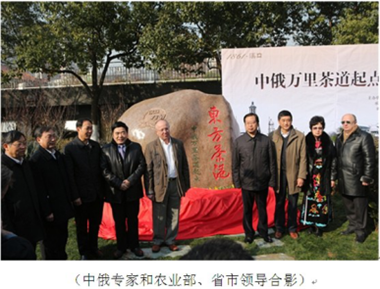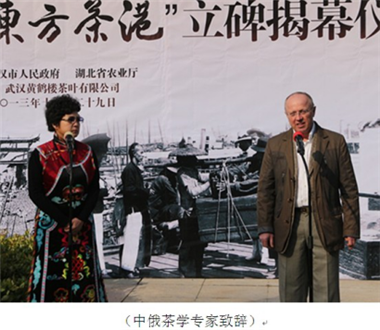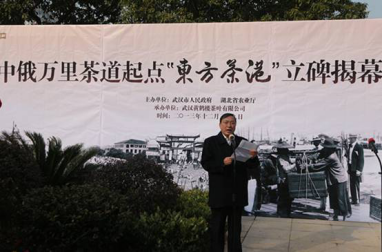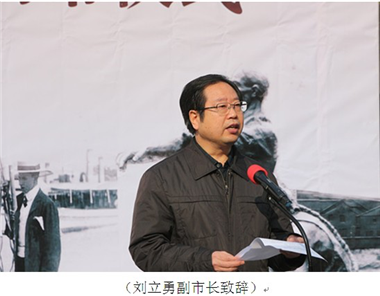Current position: > ENGLISH > COD Application Verification > Part5 >
[5.9]Wuhan: Oriental Tea Port
Release time:2017-09-10 12:10
|
Monument Unveiling Ceremony of Wuhan Oriental Tea Port December 30, 2013
Vice Mayor Liu Liyong is making a speech

Photo of experts from both China and Russia and leaders of Ministry of Agriculture and Hubei Provincial and Wuhan Municipal People's Governments

Tea experts from China and Russia are making speech (www.cjn.cn; Li Yong) The unveiling ceremony of monument of the Oriental Tea Port and the starting point of "the Ancient Sino-Russia Tea Road" was held by Hubei Provincial Department of Agriculture and Wuhan Municipal People's Government in Hankou River Beach Park on December 29. The tea experts from both Russia and China and leaders of the Ministry of Agriculture, Hubei Provincial Department of Agriculture, Wuhan Municipal People's Government and Publicity Department of the Wuhan Municipal CPC Committee have taken part in the ceremony. Vice mayor of Wuhan Liu Liyong, together with tea experts from both Russia and China, unveiled the monument of the Ancient Sino-Russia Tea Road and made ebullience speech. To celebrate the ceremony, the organizers also held the Yellow Crane Tower Cup 2013 Hubei Tea Competition.

The map that were commonly used by both Chinese and Russian merchants in the 17th century and that is preserved in Kyakhta museum of Russia Starting point of the Ancient Sino-Russia Tea Road, Oriental Tea Port Abstract: The president of PRC, Xi Jinping, visited Russia on March 23, 2013 and made wonderful speech on Following the Trend of the Times and Promoting Peace and Development in the World in Moscow Institute of International Relations. In the speech he particularly referred to that "the Ancient Sino-Russia Tea Road" in the 17th century is the new "artery of the century" connecting the two countries. The "Ancient Sino-Russia Tea Road" mentioned by president Xi Jinping is the Ten-thousand li tea road generally accepted by Chinese tea circle and also "the great Sino-Russia tea road" in the mind of Russian. This is another international trade route on the East Asia continent after decline of the Silk Road. Although it started more than 1000 years later than the Silk Road, it has incomparable economic meaning and great commodity load. Hankou, known as the "Oriental Tea Port", is the starting point and source of this Tea Road There have been three famous tea routes in history of China. The first is the "Tea Horse Road". This road is the ancient trade channel connecting Yunnan, Sichuan and Tibet. Transportation by horses enabled the trade of the tea from Yunnan and Sichuan with horses and medicines from Tibet. The second is "Tea-Horse Trading Market" which originated from the Tang and Song dynasties. The feudal rulers traded teas with the horses of the minorities living in northwestern region of China, which safeguarded the harmony among ethnic groups and unity of the state. The third is "Ten-thousand Li Tea Road" which is what we referred to as "Sino-Russia Tea Road". This tea road was called by the Russia as "great tea road". In the 17th century, it was once called as "artery of the century" connecting China and Russia. This is another international trade route on the East Asia continent after decline of the Silk Road. Although it started more than 1000 years later than the Silk Road, it has incomparable economic meaning and great commodity load. And the starting point of this "artery of the century" is right at Hankou which is called as "Oriental Tea Port" Wuhan has been flourishing in tea industry since ancient times: Wuhan was opened as a commercial port in 1861. Since then, tea and tea merchants from everywhere of China gathered here and plenty of tea factory were established here. The marvelous brick tea became famous both at home and abroad. The tea exports increased year by year and up to more than 90% of the national tea export. Therefore, Wuhan gained the reputation as Capital of Chinese Brick Tea and Oriental Tea Port. The Ancient Sino-Russia Tea Road started from Hankou, went across Han River and passed through Henan Province, Shanxi Province and the desert to Kyakhta at the border between China and Russia and then continues to extend to Moscow and St. Petersburg. This tea road linked Asia and Europe and is comparable to the Silk Road. In September 2013, Hubei Provincial Department of Agriculture and Wuhan Municipal People's Government jointly made a major decision. In order to reappear the former glory of "Oriental Tea Port", reinvigorate Hubei's tea brand, expand the influence of Hubei tea culture and brands, realize the progress from big tea province to a powerful tea province, let Hubei tea be famous both at home and abroad and comprehensively improve comprehensive tea production capacity and market competitiveness of Hubei tea, Hubei Provincial Department of Agriculture and Wuhan Municipal People's Government decided to held “2013 Hubei Tea Competition, Revisiting the Sino-Russia Tea Road and Oriental Tea Port Monument Unveiling Ceremony” on December 29, 2013. This activity will have great actions on tapping Wuhan tea's history and cultural background, carrying forward the tea culture, building tea brand, booming the tea market and developing the tea industry. The activity consisted of two parts. The first part is unveiling ceremony of "the Ancient Sino-Russia Tea Road" starting point and "Oriental Tea Port". The main reason for rise of "the Ancient Sino-Russia Tea Road" is that there is great tea market in Europe and border area of China. The nomads in border area of China and Russia mainly live on meat and milk and need tea to help digest. Therefore, a huge amount of brick tea consumption is formed among the nomads in the north. They cannot do without tea in a single day rather than without meat in three days. A Russian scholar wrote in the Baikal Border Travel Notes that both the poor and the rich, both the young and the old like drinking brick tea......no matter when you visit a family, the host will entertain you with tea." The elaborately cultivated and processed tea started from Hankou, travelled most of China and arrived at Kyakhta for trading. Then it was transported from Irkutsk, to Siberia and finally to Moscow and St. Petersburg by Russian merchants. This is the "Tea Road" across the Eurasian continent and comparable to "Silk Road" in the Han Dynasty. The Ancient Sino-Russia Tea Road is the most brilliant one among the three ancient tea roads of China. Today, we will start from Hankou again, distribute Hubei tea to the world via the Ancient Sino-Russia Tea Road to let the world rediscover Hubei tea and the "Oriental Tea Port" be well-known again and innovate this tea road to make it continue to serve as the artery of commerce and trade in the new century. The second part is "Yellow Crane Tower Cup" 2013 Hubei Tea Competition. The main participants are the well-known leading tea enterprises and associations in Hubei. The organizers hoped to make this tea competition into a well-known industry event which is authoritative and knowledgeable and has cultural connotation. This tea competition is a platform to demonstrate, recommend and introduce Hubei's famous tea and tea enterprises in a centralized way, promote tea industry development of Hubei and income increase of tea planters, create development hotspots of tea economy of China and achieve the goal of "carrying forward the culture, strengthening exchange and cooperation and booming the economy". The reason for naming this competition as "Yellow Crane Tower Cup" is to create the tea of Yellow Crane Tower brand after successfully promoting the cigarette and alcohol of Yellow Crane Tower brand. What is more gratifying is that Wuhan Yellow Crane Tower Tea Co., Ltd. has combined the modern technology with centennial royal process recently and its newly improved product Hankou Brick Tea has offered new hope for revitalizing Hankou Brick Tea. There has been a saying circulating in Hankou that "goods are marketable when being transported to Hankou and the Hankou tea is the tastiest one". Hankou rose due to tea and became flourishing due to its commercial development. For more than half century from end of the Qing Dynasty and the beginning of the Republic of China, Hankou has been the largest tea distribution center and the largest international tea trading market of China due to its advantageous geological location. According to records, tea trade of Hankou has been accounting for more than 90% of Sino-UK trade in more than 60 years since 1860 and the exported tea of Hankou reached up to four million buckets in 1871 to 1890. In this period, China's tea almost monopolized the world tea market and the tea export of Hankou accounted for more than 60% of the total tea export of China. Hence, the tea history experts said that "the majority of tea in the world comes from China while most of the China's tea originates from Hankou”. Meanwhile, "the world begins to know about Hankou of China through tea". The opening ceremony of revisiting the Ancient Sino-Russia Tea Road, Oriental Tea Port monument unveiling ceremony and tea competition kicked off the development and expansion of Wuhan tea industry in Hubei again. Not forgetting the yesterday's achievements is for better development in the future. We want to make notes for the history and maintain the historical reality. Erecting Oriental Tea Port monument here today is to memorize the great achievements of our predecessors and inspire the future generations to have pioneering spirit, pursue the excellence and reinvigorate starting point of the Ancient Sino-Russia Tea Road and remake the centennial resplendence of Oriental Tea Port? http://news.cjn.cn/sywh/201312/t2406982.htm |
That may be of interest to the article
- Ruopu CITY1000 Creative Projects
- Wuhan Design Biennale
- Wuhan Fashion Week 2018
- Great Rivers Forum
- Engineering Survey and Design Institute Dir
- Wuhan Night held in Beijing Design Week
- Message from Ms Irina Bokova on the Interna
- China's Dinosaur Egg Museum Blends the Anci
- Wuhan: Construct "Five Cultural Cities"
- 2016 Work Report of Wuhan Municipal Governm
- Regulations of Wuhan Municipality on Protec
- The WeChat Official Account of Wuhan Planni
- Wuhan Sets Up a Cultural Enterprise Credit
- Wuhan’s New 30 Articles Provides that At
- Wuhan Industrial Design Development Fund Pr
- Report on the Work of the Government and Po



